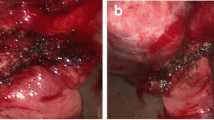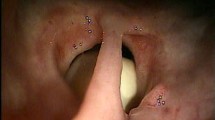Abstract
Background
Gracilis muscle interposition (GMI) has been associated with favorable outcomes in treating complex perianal fistulas. Outcomes of GMI may vary according to the fistula etiology, particularly between rectovaginal fistulas in women and rectourethral fistulas (RUF) in men. The aim of this study was to assess the outcome of GMI to treat RUF acquired after prostate cancer treatment.
Methods
This retrospective cohort study included male patients treated with GMI for RUF acquired after prostate cancer treatment between January 2000 and December 2018 in the Department of Colorectal Surgery, Cleveland Clinic Florida. The primary outcome was the success of GMI, defined as complete healing of RUF without recurrence. Secondary outcomes were length of hospital stay and postoperative complications.
Results
This study included 53 male patients with a median age of 68 (range, 46–85) years. Patients developed RUF after treatment of prostate cancer with radiation (52.8%), surgery (34%), or transurethral resection of the prostate (TURP) (13.2%). Median hospital stay was 5 (IQR, 4–7) days. Twenty (37.7%) patients experienced 25 complications, the most common being wound infection and dehiscence. Primary healing after GMI was achieved in 28 (52.8%) patients. Fifteen additional patients experienced successful healing of RUF after additional procedures, for a total success rate of 81.1%. Median time to complete healing was 8 (range, 4–56) weeks. The only significant factor associated with outcome of GMI was wound dehiscence (p = 0.008).
Conclusions
Although the initial success rate of GMI was approximately 53%, it increased to 81% after additional procedures. Complications after GMI were mostly minor, with wound complications being the most common. Perianal wound dehiscence was significantly associated with failure of healing of RUF after GMI.

2018 Wolters Kluwer

Similar content being viewed by others
References
Basler J. Enterovesical fistula. Available online at https://emedicine.medscape.com/article/442000-overview. Accessed 27 Sep 2022
Keady C, Hechtl D, Joyce M (2020) When the bowel meets the bladder: optimal management of colorectal pathology with urological involvement. World J Gastrointest Surg 12:208–225
Driver CP, Anderson DN, Findlay K et al (1997) Vesico-colic fistulae in the Grampian region: presentation, assessment, management and outcome. J R Coll Surg Edinb 42:182–185
Krco MJ, Jacobs SC, Malangoni MA, Lawson RK (1984) Colovesical fistulas. Urology 23:340–342
Chen S, Gao R, Li H, Wang K (2018) Management of acquired rectourethral fistulas in adults. Asian J Urol 5:149–154
Mundy AR, Andrich DE (2011) Urorectal fistulae following the treatment of prostate cancer. BJU Int 107:1298–1303
Tran H, Flannigan R, Rapoport D (2015) Transperineal approach to complex rectourinary fistulae. Can Urol Assoc J 9:E916–E920
Nicita G, Villari D, Caroassai Grisanti S, Marzocco M, Li Marzi V, Martini A (2017) Minimally invasive transanal repair of rectourethral fistulas. Eur Urol 71:133–138
Choi JH, Jeon BG, Choi SG, Han EC, Ha HK, Oh HK (2014) Rectourethral fistula: systemic review of and experiences with various surgical treatment methods. Ann Coloproctol 30:35–44
Samplaski MK, Wood HM, Lane BR, Remzi FH, Lucas A, Angermeier KW (2011) Functional and quality-of-life outcomes in patients undergoing transperineal repair with gracilis muscle interposition for complex rectourethral fistula. Urology 77:736–741
Voelzke BB, McAninch JW, Breyer BN, Glass AS, Garcia-Aguilar J (2013) Transperineal management for postoperative and radiation rectourethral fistulas. J Urol 189:966–971
Vanni AJ, Buckley JC, Zinman LN (2010) Management of surgical and radiation induced rectourethral fistulas with an interposition muscle flap and selective buccal mucosal onlay graft. J Urol 184:2400–2404
Zmora O, Potenti FM, Wexner SD et al (2003) Gracilis muscle transposition for iatrogenic rectourethral fistula. Ann Surg 237:483–487
Yellinek S, Sousa CB, Gilshtein H, Strassmann V, da Silva G, Wexner SD (2021) Gracilis muscle interposition for treatment of complex anal fistula: experience with 119 consecutive patients. Dis Colon Rectum 64:881–887
Ramírez-Martín D, Jara-Rascón J, Renedo-Villar T, Hernández-Fernández C, Lledó-García E (2016) Rectourethral fistula management. Curr Urol Rep 17:22
Lane BR, Stein DE, Remzi FH, Strong SA, Fazio VW, Angermeier KW (2006) Management of radiotherapy induced rectourethral fistula. J Urol 75:1382–1387
Harris CR, McAninch JW, Mundy AR et al (2017) Rectourethral fistulas secondary to prostate cancer treatment: management and outcomes from a multi-institutional combined experience. J Urol 197:191–194
Mansfield JT, Stephenson RA (1996) Does transurethral resection of the prostate compromise the radical treatment of prostate cancer? Semin Urol Oncol 14(3):174–177 (PMID: 8865480)
Falavolti C, Sergi F, Shehu E (2013) York Mason procedure to repair Iatrogenic Rectourinary Fistula: our experience. World J Surg 37:2950–2955 https://doi.org/10.1007/s00268-013-2199-y
Hechenbleikner EM, Buckley JC, Wick EC (2013) Acquired rectourethral fistulas in adults: a systematic review of surgical repair techniques and outcomes. Dis Colon Rectum 56:374–383
Ghoniem G, Elmissiry M, Weiss E, Langford C, Abdelwahab H, Wexner S (2008) Transperineal repair of complex rectourethral fistula using gracilis muscle flap interposition–can urinary and bowel functions be preserved? J Urol 179:1882–1886
Emile SH (2020) Recurrent anal fistulas: when, why, and how to manage? World J Clin Cases 6(8):1586–1591
Mei Z, Wang Q, Zhang Y et al (2019) Risk factors for recurrence after anal fistula surgery: a meta-analysis. Int J Surg 69:153–164
Gilshtein H, Strassman V, Wexner SD (2020) Redo gracilis interposition for complex perineal fistulas. Tech Coloproctol 24:475–478
Sharma RK, Parashar A (2012) The management of perineal wounds. Indian J Plast Surg 45:352–363
Funding
None.
Author information
Authors and Affiliations
Corresponding author
Ethics declarations
Conflict of interest
Dr. Wexner reports receiving consulting fees from ICON Language Services, IntuitiveSurgical, Stryker, Medtronic, Takeda, ARC/Corvus, Astellas, Baxter, Olympus, Livsmed, GI Supply, and Leading BioSciences and receiving royalties from Medtronic, Intuitive Surgical, Karl Storz Endoscopy America Inc, and Unique Surgical Innovations, LLC.
Ethical Approval
Data used in the study were derived from an IRB-approved (FLA 14-039) database of the Department of Colorectal Surgery, Cleveland Clinic Florida.
Informed Consent
Informed consent to particpate in the study was waived due to the retrospective nature of the study.
Additional information
Publisher’s Note
Springer Nature remains neutral with regard to jurisdictional claims in published maps and institutional affiliations.
Rights and permissions
Springer Nature or its licensor (e.g. a society or other partner) holds exclusive rights to this article under a publishing agreement with the author(s) or other rightsholder(s); author self-archiving of the accepted manuscript version of this article is solely governed by the terms of such publishing agreement and applicable law.
About this article
Cite this article
Emile, S.H., Horesh, N., Strassmann, V. et al. Outcomes of gracilis muscle interposition for rectourethral fistulas caused by treatment of prostate cancer. Tech Coloproctol 27, 937–944 (2023). https://doi.org/10.1007/s10151-023-02759-5
Received:
Accepted:
Published:
Issue Date:
DOI: https://doi.org/10.1007/s10151-023-02759-5




